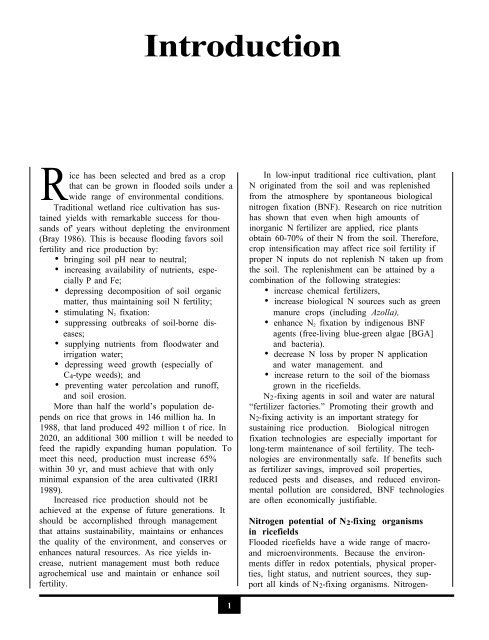Azolla - IRRI books - International Rice Research Institute
Azolla - IRRI books - International Rice Research Institute
Azolla - IRRI books - International Rice Research Institute
- No tags were found...
You also want an ePaper? Increase the reach of your titles
YUMPU automatically turns print PDFs into web optimized ePapers that Google loves.
Introduction<strong>Rice</strong>has been selected and bred as a cropthat can be grown in flooded soils under awide range of environmental conditions.Traditional wetland rice cultivation has sustainedyields with remarkable success for thousandsof' years without depleting the environment(Bray 1986). This is because flooding favors soilfertility and rice production by:• bringing soil pH near to neutral;• increasing availability of nutrients, especiallyP and Fe;• depressing decomposition of soil organicmatter, thus maintaining soil N fertility;• stimulating N 2 fixation:• suppressing outbreaks of soil-borne diseases;• supplying nutrients from floodwater andirrigation water;• depressing weed growth (especially ofC 4 -type weeds); and• preventing water percolation and runoff,and soil erosion.More than half the world’s population dependson rice that grows in 146 million ha. In1988, that land produced 492 million t of rice. In2020, an additional 300 million t will be needed tofeed the rapidly expanding human population. Tomeet this need, production must increase 65%within 30 yr, and must achieve that with onlyminimal expansion of the area cultivated (<strong>IRRI</strong>1989).Increased rice production should not beachieved at the expense of future generations. Itshould be accornplished through managementthat attains sustainability, maintains or enhancesthe quality of the environment, and conserves orenhances natural resources. As rice yields increase,nutrient management must both reduceagrochemical use and maintain or enhance soilfertility.In low-input traditional rice cultivation, plantN originated from the soil and was replenishedfrom the atmosphere by spontaneous biologicalnitrogen fixation (BNF). <strong>Research</strong> on rice nutritionhas shown that even when high amounts ofinorganic N fertilizer are applied, rice plantsobtain 60-70% of their N from the soil. Therefore,crop intensification may affect rice soil fertility ifproper N inputs do not replenish N taken up fromthe soil. The replenishment can be attained by acombination of the following strategies:• increase chemical fertilizers,• increase biological N sources such as greenmanure crops (including <strong>Azolla</strong>),• enhance N 2 fixation by indigenous BNFagents (free-living blue-green algae [BGA]and bacteria).• decrease N loss by proper N applicationand water management. and• increase return to the soil of the biomassgrown in the ricefields.N 2 -fixing agents in soil and water are natural“fertilizer factories.” Promoting their growth andN 2 -fixing activity is an important strategy forsustaining rice production. Biological nitrogenfixation technologies are especially important forlong-term maintenance of soil fertility. The technologiesare environmentally safe. If benefits suchas fertilizer savings, improved soil properties,reduced pests and diseases, and reduced environmentalpollution are considered, BNF technologiesare often economically justifiable.Nitrogen potential of N 2 -fixing organismsin ricefieldsFlooded ricefields have a wide range of macroandmicroenvironments. Because the environmentsdiffer in redox potentials, physical properties,light status, and nutrient sources, they supportall kinds of N 2 -fixing organisms. Nitrogen-1
















